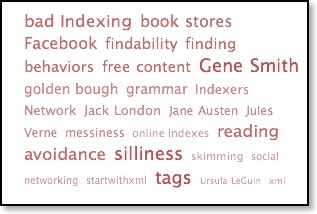At the top of the page, you see a navigation bar with broad topics. Breaking information into broad chunks for a web page is much like providing a table of contents. This is a "top down" findability device. As long as you the reader thinks in the same categories as the developer of the information does, you will find things quickly with a navigation bar or table of contents. But if you are thinking in different ways, this may not be your most effective tool. Navigation bars and tables of contents help people take a top down approach, and explore and drill down into information. They are exploratory.
But let's say you aren't in an exploratory mode of information gathering. You want to know a specific fact, such as whether or not Wright Information does embedded indexing. You may not know whether to look in credentials, under software, or under rates to find that specific piece of information. Two accessibility tools are here to help: the search engine on the front page, and the index. The search engine will give you results for each page, without much fuss. The index will show you that indeed, yes, there's information here about embedded indexing.
Which works better? It depends on the size of the body of information you are searching. In a small site, both will get you to what you need quickly. But let's say you have a grammar site, and you want to look up when to use "which" and when to use "that." The search engine will not help you, you need an analyzed index to get you the precision you want.
At the bottom of this page, you see "bread crumbs" - a method of telling you where you are in a site. These are often used to help navigate taxonomies. They are a means of showing you where in a hierarchy of terms or pages you are, and lets you know the next broadest category upward. This is usually helpful. People have a much easier time thinking of subdivisions, and have a much harder time thinking upwards to a next broader topic. Implementing a taxonomy and displaying portions of it to a user gives them not only their location, but hints of what the next higher topic might be, as well as subdivisions beneath and related terms that are equal in stature. On this site, subdivisions are found in the side menus.
An example of bread crumbs:

On many blogs, you can see the implementation of a tag cloud and categories. These are implemented by tagging the blog posts with a category and descriptors. The cloud shows the number of uses for a particular term by making it larger, and you can easily view all the posts for a tag by clicking on it. If multiple people were feeding tags into the system, you would have a folksonomy - a tool that takes everyone's labels and merges them together. Folksonomies are powerful tools for gathering data on records by using a group approach and leveraging the labor. At some point they become chaotic, and a more controlled vocabulary is needed. The tag cloud on the blog page, and the index for the site, are both controlled vocabularies.
An example of a tag cloud:

Contact Wright Information at jancw@wrightinformation.com,
or call 505-281-2600